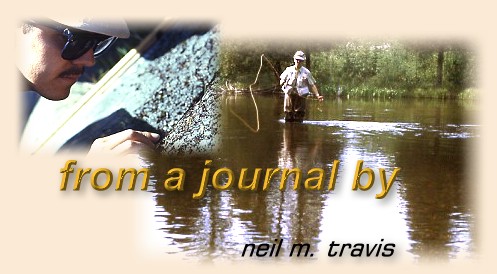Reading Trout Water
By Neil M. Travis, Montana/Arizona
I presume most of my readers have never heard of Ray Ovington
and his book Tactics On Trout that was published
in 1969. It's a rather impressive tome, 286 pages plus two appendixes
and index. The jacket contains the following description of what the
book contains: "This uniquely concrete book teaches the angler how
to 'read' trout water and, with the help of numerous precise procedural
drawings, exactly how to wade, cast, and fish out each of 33 different,
but typical, kinds of trout pools." That's a rather ambitious, and perhaps
a somewhat presumptuous assertion; however Mr. Orvington does a
rather admirable job of taking the mystery out reading trout water. The
volume I have in my library cost a princely sum of eight dollars and
ninety-five cents, and while it's unlikely you can find one for that price
today it might be possible to find a copy in a used bookstore.
While Mr. Ovingston's book is a detailed approach to various
types of trout water as a practical matter it is a bit over the top.
Reading trout water is not as complicated as this book would
indicate, and fishing by the numbers is seldom very successful
or satisfying.
From the trout angler's perspective trout need two things: food and
cover. The ideal spot has both of these characteristics, but trout will
move from cover to find food. First let's examine what constitutes
cover from a trout's perspective.
Some forms of cover are obvious. Undercut banks, weed beds,
partially submerged logs, and overhanging brush all are obvious
places for a trout to seek shelter, but trout also utilize other forms
of cover. Trout will often use relatively shallow water in riffle areas
or white water runs. The broken surface of the water makes it
difficult for aerial predators and anglers to detect their presence.
Trout also seek cover in deep holes or runs. An ideal situation from
a trout's perspective is a shallow area that tapers into a deep hole.
During periods when they are not actively feeding they can hang
out in the deeper water, and then move up into the shallower water
to feed. If danger should threaten they can quickly move back into
the security of the deeper water.
The angler should realize that trout will rarely linger for very long in
areas of heavy flows unless those flows are broken by rocks, logs
or other in stream structures. A trout cannot afford to expend the
energy necessary to constantly fight the current in such areas, and
will generally only spend a short period of time in such locations
when chasing some food form or when moving from one location
to another. If you observe trout in areas of heavy flows you will
notice that they hold behind rocks or other structures that break
the current, or very close to the bottom where friction decreases
the force of the flow.
The angler needs to recognize where trout find cover so as to
avoid spooking the fish from those areas. I have watched anglers
walking along the edge of a stream that had undercut banks and
overhanging grass and brush and spook every trout in that entire
stretch of stream. Careless wading through riffles may chase all
the fish into deeper water and ruin any chances that the angler
might have had to fish to those fish. In heavily fished waters the
trout may recover relatively quickly from being spooked by the
careless angler, but in situations where the trout do not see lots
of anglers a spooked trout is a trout that the angler will not see
for the rest of the day.
Trout select feeding stations based on a series of factors. High on
the list are locations where the trout does not have to expend much
energy to fill his stomach. Favored areas are just below riffles where
the current smooths out, current seams where a faster flow encounters
a slower flowing section of water, slower flowing areas immediately
adjacent to the bank, immediately behind a rock or other obstruction
in the current, and the tails of long pools. The angler should look for
places where the currents concentrate food items in a relatively
narrow area.
When trout move from cover to a more exposed area to feed they
tend to be more inclined to flee back to cover if they perceive any
type of threat. Since attack usually comes from above the sudden
appearance of an angler on the bank, a large bird flying overhead,
or the flash of a rod or fly line are usually enough to send them fleeing.
Trout feeding in shallow water are most vulnerable and tend to be the
most skittish.
Reading trout water is not a mysterious ability only achieved by
a select few, but simply a matter of common sense. Whether you
are wading an Eastern free stone stream or casting to trout on a
Western spring creek if you look for areas where the trout can
find cover, and areas where food is easy to secure you can be
certain that is where you will find the trout. Like a good mystery,
when you get it figured out it all seems so simple, and it really is. ~ Neil M. Travis, Montana/Arizona
From A Journal Archives
|

